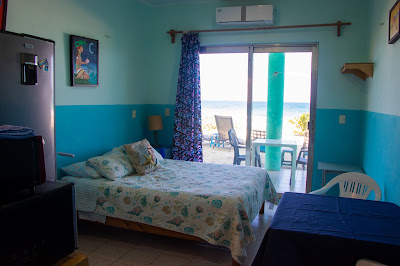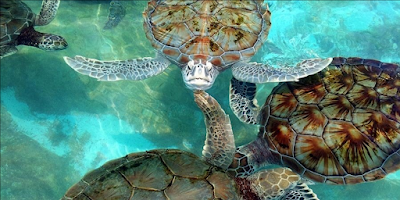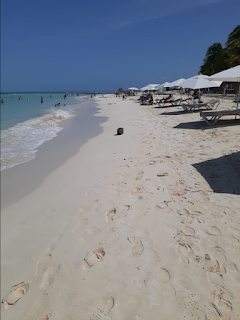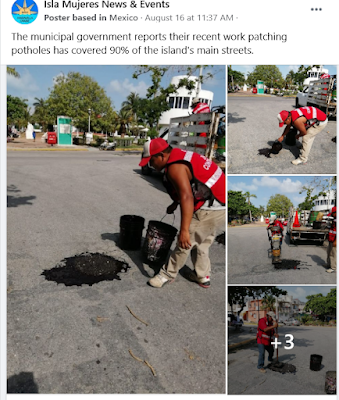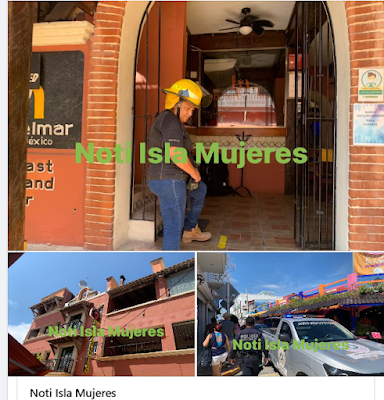This
week, Isla Mujeres will commemorate the 171st anniversary of it
founding as the town of Dolores. This is my translation of an article
about the island's early settlers written last year by Fidel Villanueva
Madrid, the town historian. LINK to original post in Spanish.
On the occasion of the 170th
anniversary of the Foundation of the City of Isla Mujeres, I will
present below some information about that event, which is part of an
extensive work that took me many years to structure, until I achieved
what is considered a study on the origin of the population and the
settlement of this town.
Before
going fully into the subject, I will make, at the request of some
readers, a clarification on two of the most important dates recorded in
the History of Isla Mujeres which are the Spanish Discovery and the
Foundation of the City, which are sometimes confused with one another.
A). - In the case of the Spanish Discovery, it occurred in March of the year 1517.
- The Foundation of the City of Isla Mujeres was in August 1850.
In
other words: There are three hundred and thirty-three years (333),
between one event and another. It is essential to be very clear about
this, because for each of those dates a series of historical events was
generated that all islanders should know.
Let's now read about the Foundation of the City of Isla Mujeres.
Background
As a very brief background, I will note that until 1847 Isla Mujeres
was a lonely place off the eastern coast of the Yucatan Peninsula, and
that no one would have supposed that a year later there would be a human
settlement, where before the silence was only broken by the sound of
the sea and the the murmur of the breezes in the palm trees, in a song
of nature that seemed eternal.
However, political tensions among the Yucatecans of that time,
whose upper class lived in opulence thanks to exploitation of the Maya,
would unleash a bloody struggle that would modify the political
geography of Yucatán.
The truth is that during the three centuries of Spanish colonialism
the Mayans rose up several times, but they were always subdued. But on
this occasion, the uprising scored resounding successes that put the
Yucatecans on the run, when the wealthiest went to foreign places to
take refuge, while those who did not have money to go further were left
in the Mexican ports.
The unstoppable advance of the Mayans and their resounding
triumphs in combat were due to the supply of arms and ammunition they
received from the British in Belize. Thanks to this, by the beginning of
1848, only Campeche, Mérida and Valladolid were not in their power; and
by March of that year, after almost three months of siege, Valladolid
fell, the most important city in eastern Yucatan, where thousands of
inhabitants had found refuge who were from other communities held by the
rebels.
After Valladolid fell, the rebels turned their attention on
Mérida, which they did not take for reasons attributed to the arrival of
the sowing season, since they abandoned the battlefront that they had
in place on the outskirts of that city.
In the case of the repopulation of Isla Mujeres, the debacle of
Valladolid had a lot to do with it, since the people were unable to
flee to Mérida or Chemax because the roads were busy, so they tried to
escape to the north, towards the coast, doing so in chaos. At the end
of that month of March, hundreds of these desperate people arrived at a
place called El Cerrito, a promontory with pre-Hispanic ruins that was
surrounded by water, where they defended themselves against harassment
by the Mayans, who tried by day and by night to approach the raised area
of land, and were repelled by the stones and sticks of the occupants,
who didn't have weapons. There was no hope that troops would arrive to
help them, because when Valladolid fell the soldiers of the National
Guard had deserted, after months of being besieged, without water, food
and salaries. Not to mention the volunteers.
Returning to the north coast of Yucatán, I will say that it was
until the end of April when ships from Cuba and Campeche transferred the
survivors to Isla Mujeres, which was a stopover for a majority who
continued to flee south, towards Cozumel and places in Belize, where
they founded new communities, such as Sarteneja.
The survivors of the odyssey lived for more than a month on
El Cerrito, with an average of 30 people dying daily, as a result of
the strong sun and heat, diseases, infected wounds, hunger and thirst,
with the children and elderly contributing the highest number of deaths.
It is important to add that those who took refuge on the
islands were mostly mestizo, as evidenced by the relations of
inhabitants and censuses of that time, thus eliminating the thesis,
sustained for many years, that those who settled on the islands as a
result of the war they were white or Spanish.
More clearly, the conflict, which for some was not a Yucatan
Caste War, but a Social War, in response to several castes led by the
so-called whites or "ladinos" (European descendants), followed by the
creoles, mestizos, indigenous or "macehuales", as well as the mulattoes
and "pardos" (multi-racial, usually with African blood,), who were
ethnic groups that were not very representative in number.
Among all these social classes, that of the mestizos was not
embraced either by whites or by Mayans, for the simple reason of being
the result of the mixture of both. They were therefore the ones who
suffered the greatest atrocities on the part of the conflicting sides.
I reiterate then, that the founders of the City of Isla Mujeres
were mestizos, and I add that they were all "Labradores de la Tierra"
(cultivators of the soil), so they had to adapt to the environment.
Foundation of the Town of Dolores, in Isla Mujeres
I should also make it clear that Isla Mujeres was not founded in
1850, but rather a town on its northern part, which was given the name
of Dolores to celebrate the place where the priest Miguel Hidalgo began
the struggle for Independence.
The official foundation was by decree, which was granted after
repeated requests made by the residents to the Yucatecan government
since 1847. Those requests and pleas for help from the refugees on the
island were like "screams in the desert", because the government was
occupied with the war and gave them no attention.
The most relevant figure in Isla Mujeres in those years was
Bartolomé Magaña, a folksy tailor-fisherman who "carried the new town on
his back", supported by a group of people whom he treated as his City
Council, since they were consulted about everything.
Religion is a topic which is not well-known in regard to
the founding of the City of Isla Mujeres . According to documents in my
files, the support of the Catholic Church was key for the decree to be
issued. I cite as an example that, when the Yucatecan legislature
approved the instrument of law, immediately, on August 20, 1850, the
Bishopric (Diocese) of Yucatan issued a statement aimed at finding a
priest willing to take charge of the island's Catholic flock.
Published on August 21, 1850, the text is as follows:
"SECRETARIAT OF THE BISHOP
The
Isla Mugeres community, which is already numerous and belongs to this
Diocese, asks His Excellency the Bishop, for the organ of its Justice of
the Peace, a priest to administer the Holy Sacraments. The Congrua
(opportunity), which is proposed is competent and apparently safe. By
virtue of this, Your Illustrious Honor orders me to invite by this
notice to the ecclesiastical gentlemen who want to choose the
destination, so that by approaching this office, they impose the
aforementioned congrue (income, economic provision), and other
advantages for the immediate provision.
Mérida Yucatán August 20, 1850. - Diego Lorena. - Senior Officer of the Secretariat of the Bishopric.- "
As we know, the Catholicism was the only religion and mandatory in Mexico at that time.
On
the other hand, I must add that those who founded the City of Isla
Mujeres were guardians of our sovereignty on the eastern coast of
Yucatán, since by 1850 the expansionist efforts of the British had
already far exceeded the banks of the Río Hondo, which evoked constant
complaints by the Yucatecans. As proof of the above, I point out that on
Wednesday May 12, 1850, in its edition No. 271, the Official Gazette of
the Government of the State of Yucatán reported that:
From 1848 the American Consul in Belize, Mr. Hempstead wrote
several notes to Mr. Buchanan, Minister of State in Washington,
informing him of the English aid to the Indians and expressing his
opinion that they wished to establish a protectorate over those Indians
as they had done it in the territory of Los Mosquitos; and he warned him
that if they did, Great Britain would have full possession of the
Atlantic coast from León de Nicaragua to Cape Catoche. " (Cape Catoche
is about 40 miles north of the island, in our municipality.)
Under the pretext of cutting "palo de tinte" (a valuable
timber-export used for dye), the British had occupied various points on
the eastern coast of Yucatan, and that same year, 1850, it was reported
that up to 700 cutters of the so-called Palo de Campeche were settled in
Cape Catoche, and that the 'Mayan Indians' helped them in the task, in
exchange for support for their cause.
It was for this reason that from Yucatan saw the benefits of
"repopulation" of the islands, where the migratory phenomenon was at its
highest between 1847 and 1850.
Finally, on August 17, 1850, the Congress of the State of Yucatán by decree ordered:
"Article
1. The point currently inhabited in the northern part of Isla Mujeres
stands as a town with the name of Dolores and will correspond to the
party of Tizimín. "
The
four-page document establishes a series of concessions and exemptions
that are worth analyzing separately, to understand the complex network
of interests and motives that underpinned each of the provisions that
were considered.
Without
going into too much detail, I would point out that the settlers were
left with all the responsibilities, from drawing out the lines of the
town and the arrangement of public areas, in addition to constructing a
public house, a school, a cemetery and a barracks, as well as placing
the best possible layout of streets and "ornato publico" for the new
population.
After being approved by Congress, the Decree entered into force on
the 21st of that same month, when it was published by the government of
Yucatán, which was under the government of Miguel Barbachano y Tarrazo.
But I will leave here the comments to the decree, making a
commitment to address it in detail next time, and I will go on to
record:
Who came first ... and who stayed
In my search for information about the founding of the city, I had
to turn to researchers such as Michel Antochiw (RIP), who always kindly
supported me, both with historical information, and opening the doors of
other documentary sources, both foreign and Mexican.
Because I am one of those who has in mind that gratitude is a
great human virtue, I express it to Michel Antochiw from these lines,
for the many years he helped me in the difficult task of locating data
about this region of the Caribbean where Isla Mujeres is located,
especially because we do not have historical archives in our town.
Likewise, I have eternal gratitude for historians and
researchers such as María Teresa Gamboa (RIP), archaeologists José Luis
Ruz Escalante, Luis Leira Guillermo (RIP), Luis Aveleyra Arroyo-de Anda
(RIP), and Enrique Terrones González, among others.
With his wisdom, and with the support of documentary sources
such as the first relationships of settlers of Isla Mujeres (1850-56),
of the Civil Registries of Cozumel, Valladolid, Mérida, and of Isla
Mujeres itself, as well as in a Census published in 1866, I was able to
define the first surnames and names that were heard after 1847 on this
island, which I will relate, including in some cases their origin.
I must also say that trained people such as Leticia Rodríguez
Medina and Marina Ávila Canto, helped me in the meticulous work of
reviewing old records, so that after 8 years we could establish that,
between 1850 and 1870, they were 468 inhabitants registered in Isla
Mujeres, with only 126 different surnames.
In order to also know the ethnic ancestry of the founders of
this city, I will point out that, of the 126 registered surnames, 106
are of Hispanic origin, and the other 20 Mayan; that is, only 19% of the
new settlers were of the same race as the rebels, while the vast
majority were of mixed descent.
I
will add that of the 126 surnames, 40 are the most prolific, repeating
themselves 3 or more times in the two decades, so I deduce that these
families were the most numerous in Isla Mujeres at the time in question.
Of all, the surname Rodríguez is the one that appears most
frequently, (13) followed by Gómez (12), Martínez (10), Perera and Ávila
(, Pérez and Rivero (7), Magaña, Coral and Paz (6 ), Pastrana, Osorio,
Trejo, Castilla, Díaz, Aguilar and Argüelles (5), Novelo, Allen, Chalé,
Tuz, Azueta, Villanueva, Sabido and Sánchez (4), Ancona, Basto, Brito,
Caamal, Castro, Escalante, Godoy, Garrido, Kumul, Maldonado, Ojeda,
Povedano, Velázquez, Xooc and Cupul (3 each).
Based on the above, I was able to define surnames that have prevailed to this day as the following:
Ancona
Arguelles Ávila Azueta Basto Canto Castilla Castro Celis Coral Díaz
Delgado Encalada Fernández García Garrido Gasca Gómez Magaña Martín
Martínez Nájera Novelo Osorio Pastrana Paz Pérez Povedano Rivero
Rodríguez Rosado Sabatini Sabido Sánchez Tejero Trejo Velázquez Xooc
Zetina
Some of them cease to be heard, since they are carried in our days
by maternal lineage. An example of the above are the surnames Sabido and
Azueta.
I include those of Delgado, Tejero and Xooc as founders, because
even when they do not appear in censuses or lists, they are cited in the
records of the Historical Civil Registry on several occasions as
residents of the island since 1850.
As for the first to arrive between 1847 and 1850, I was able to establish that they were the following people:
Bartolomé Magaña, who was 31 years old when he came from Campeche in
1847, and who married Mrs. Carlota Novelo, originally from Valladolid.
Pedro Román Aguilar, another Valladolid native, who in 1850 had two
daughters: María and Albina, aged 20 and 22, respectively.
Martín Ancona Ortiz, who, in the reference year, appears to be 28
years old. I make a parenthesis to point out that, contrary to what is
believed, the Ancona surname belongs to the founders. That they had
emigrated over some years to San Pedro, Belize; Cozumel, Payo Obispo and
particularly Holbox does not take away that credit.
I return to the subject with Saturnino Argüelles, originally from
Dzemul, who was 17 years old at the time. Also, José María Azueta, 24
on that date, of Spanish origin. Without leaving the year I will mention
that these were also founders: Josefa Baeza, a native of Izamal, 28
years old; Isidra Canto, from Telchac, 16; Fernando Cetina from
Valladolid, 22; Juan Coral de Dzidzantún, 14; Juan Cupul,13; Faustina
Chalet, 20; Mateo Chan Salazar, 16; Secundina Franco,13; José García
Moreno, 15; Silveria Garrido, 12; Gregorio Gasca, 19; and Laureana
Martínez, from Dzidzantún, 16.
I will continue with Isidoro Novelo from Valladolid, 24; Isidro
Novelo May, 13; Timoteo Paz, 30, who came from Dzemul; Juana Pereira,22;
Tomasa Perera, 42, originally from Valladolid; Felipe Rodríguez, 16;
Bartolomé Rodríguez, 15; José María Rodríguez, 14; and Pedro Povedano,
whose age was close to 50 years old, and who was dedicated to fishing,
who said he was a native of the Canary Islands, and liked to talk about
his adventures with pirates.
I will conclude with Facundo and José Julio Rosado, 15 and 13
years old respectively; Luis Sánchez,15; María del Carmen Tah, 12; María
de Jesús Trejo, 16, who came from Dzidzantún accompanied by Atilano
Trejo, her brother, just 11 years old; in the same way other brothers
arrived, Miguel and Manuel Tuz, 13 and 15 years old; also Marcelina
Uc,13; and we close the list of the first islanders with Romualdo
Velázquez, who in 1850 was 36 years old.
Later, as the conflict between the parties diminished, the
founding Mayans emigrated; some to Yucatán where they earned well
because henequen's golden age was beginning, and others to the
continental part of our municipality, where the exploitation of palo de
tinte and other forest resources gained a singular boom. An example of
the above is the last name Tah, very common today in Kantunilkín,
municipality of Lázaro Cárdenas (the bordering municipality that
includes Holbox).
Let us not forget that, because of tinto de palo/dyewood and other
precious woods first, and then the chicle gum industry later, towns such
as the so-called "Rancho Islote Chacmuchuch" flourished, which came to
register more than 1000 inhabitants (1896); also Punta Arenas, which
reported more than 200 residents in its heyday; Vista Alegre - Punta
Chen, which registered 135; Holbox with 30; Punta Alegre with 33;
Chiquilá (formerly Nueva Málaga), with 6; Río Turbio with 9; the latter
dated in 1866, as well as others of lesser population size. (Chacmuchuch
is the swamp-lagoon by Isla Blanca/Playa Isla Mujeres on the mainland
part of the municipality of Isla Mujeres, Chiquila is on the mainland by
Holbox)
On the other hand, among those who arrived because of the Caste
War were young men fleeing conscription; as well as orphans, invalids,
widows and widowers. Even though the information on Isla Mujeres from
the second half of the 19th century is quite scarce, in terms of
population censuses we have the first one mentioned, which was carried
out in 1850, and then another one was carried out in 1862, plus its
results. which were both questioned and even dismissed. The count for
that year indicated that there were 539 inhabitants on Isla Mujeres, 709
on Cozumel and 34 on Holbox.
In 1865 Salazar Ilarregui, Commissar of the Empire in Yucatan,
ordered the conductin of another census, with Mr. José Eugenio Rodríguez
in charge, a citizen of Merida who was appointed as Judge of the Civil
Registry in this locality. The collection was reported on October 18 of
that year and published in 1866. At the municipal level, Isla Mujeres
registered a total of 718 inhabitants, including the neighboring towns
that were:
Population-Number. Of Inhabitants
Punta Chen-135
Punta Alegre-33
Holbox-30
Rancho Lab – Cah-19
Rancho Río Turbio-9
Punta Tunich-8
Rancho Santa Fe-7
Rancho Chiquilá-6
Rancho Santa María-3
The
Town of Dolores reported 468 inhabitants, of which 247 were female and
221 male. Among its final numbers, the aforementioned census reported
that the population of the municipality was made up of:
White Males-199
Indian Males-59
White Females-254
Indian Females-88
Children of Both Sexes-118
Due to their mental and physical deficiencies, two crazy people and a blind man were reported.
Despite the cholera pandemic
As we can see, the founders of the city of Isla Mujeres were a
heterogeneous group of people who came from various parts of the Yucatan
Peninsula.
Their racial origin was mostly mestizo, so their cultural
background was the same, in terms of uses and customs, which were
enriched by the contributions of the Cuban-Spanish fishermen who
frequented Isla Mujeres at that time.
The truth is that it is to them that we owe the arts of fishing
techniques and marine knowledge, which helped so that, within a few
years, despite the isolation and hostile environment, on the small
island the four hundred refugees found the haven of peace they had
sought when fleeing the horrors of war.
They soon became accustomed to hurricanes, which hit them twice in the 1850s and 60s.
Their stature as brave and determined human beings is gigantic
when we remember that they suffered a deadly pandemic in those years, of
cholera, that decimated humanity for decades, and which was only
controlled when the cure for the terrible illness was found.
In short, I hope that what has been said will serve to measure,
understand and recognize what the founders sacrificed to lay the
foundations of the modern city where we live.
The key to their success was based on unity. This is something that we very much need now.
I
close this writing here as a tribute to the 170 years of the City of
Isla Mujeres. I leave it to the scrutiny of those who read it. I will
appreciate knowing any omissions or unintentional errors that it may
contain.
And my congratulations for the efforts made by the municipal
government so that this date does not go unnoticed, thanking them once
again for the support they provide to my work.
Fidel Villanueva Madrid.
Historian of Isla Mujeres.
August of 2020. -
Translation by Ronda Winn-Roberts




















